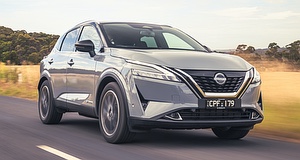
Overview
Nissan has taken an unconventional approach to electrifying its powertrains by introducing the e-Power model to its lineup, which now includes the Qashqai compact SUV. This move might raise some eyebrows for several reasons.
The new petrol-electric variant of the Qashqai is initially offered only in Ti specification, priced at $51,590 plus on-road costs. This marks a $4,200 increase over the turbo-petrol Ti, placing it at the higher end of the price spectrum for a small front-wheel-drive SUV from a mainstream brand.
Nissan justifies the premium by highlighting the smoothness of the driving experience, lower fuel consumption, increased power and torque, and minimal compromises compared to traditional internal combustion engine models. However, upon closer examination, the official combined cycle fuel consumption only sees a modest decrease of 0.9 liters compared to the ICE models, registering at 5.2 liters per 100 kilometers. While the power output is higher at 140kW/330Nm compared to 110kW/250Nm in conventional models, the e-Power variant carries an additional 205kg of weight, tempering the performance gains.
Despite minor compromises such as the lack of a space-saver spare tire and the use of a tire repair kit, the Qashqai e-Power offers practical advantages such as a 55-liter fuel tank capacity and a spacious 452-liter boot.
The e-Power model employs a unique powertrain setup, where a 1.5-liter turbocharged three-cylinder engine acts as a generator to power an electric motor. This system, combined with a 2.1kWh lithium-ion battery, offers three drive modes (Normal, Sport, and Eco) and Nissan’s “e Pedal Step” for single-pedal driving using regenerative braking.
In terms of features, the Ti e-Power model comes generously equipped with standard specifications including 19-inch alloy wheels, LED lighting, keyless entry, electric tailgate, leather trim, dual 12.3-inch screens with infotainment, Apple CarPlay/Android Auto, sat nav, a head-up display, heated steering wheel, heated front seats, and panoramic sunroof. Safety features include autonomous emergency braking, lane-keeping assistance, adaptive cruise control, blind-spot monitoring, and a surround-view camera.
Despite offering a smoother driving experience and impressive efficiency, the Qashqai e-Power’s ride quality may not be as refined as its ICE counterparts due to modifications made to accommodate the extra weight. Additionally, the displayed average consumption of 5.5 liters per 100 kilometers raises questions about the model’s efficiency and emissions performance compared to its petrol-powered counterparts, potentially challenging its value proposition for buyers.

